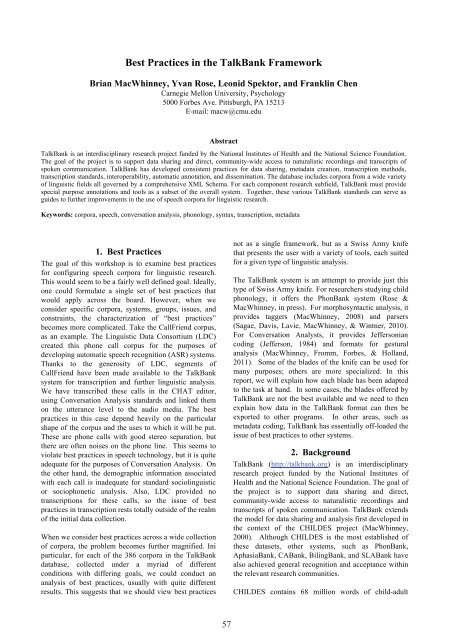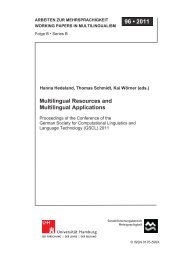Best Practices for Speech Corpora in Linguistic Research Workshop ...
Best Practices for Speech Corpora in Linguistic Research Workshop ...
Best Practices for Speech Corpora in Linguistic Research Workshop ...
You also want an ePaper? Increase the reach of your titles
YUMPU automatically turns print PDFs into web optimized ePapers that Google loves.
<strong>Best</strong> <strong>Practices</strong> <strong>in</strong> the TalkBank Framework<br />
Brian MacWh<strong>in</strong>ney, Yvan Rose, Leonid Spektor, and Frankl<strong>in</strong> Chen<br />
Carnegie Mellon University, Psychology<br />
5000 Forbes Ave. Pittsburgh, PA 15213<br />
E-mail: macw@cmu.edu<br />
Abstract<br />
TalkBank is an <strong>in</strong>terdiscipl<strong>in</strong>ary research project funded by the National Institutes of Health and the National Science Foundation.<br />
The goal of the project is to support data shar<strong>in</strong>g and direct, community-wide access to naturalistic record<strong>in</strong>gs and transcripts of<br />
spoken communication. TalkBank has developed consistent practices <strong>for</strong> data shar<strong>in</strong>g, metadata creation, transcription methods,<br />
transcription standards, <strong>in</strong>teroperability, automatic annotation, and dissem<strong>in</strong>ation. The database <strong>in</strong>cludes corpora from a wide variety<br />
of l<strong>in</strong>guistic fields all governed by a comprehensive XML Schema. For each component research subfield, TalkBank must provide<br />
special purpose annotations and tools as a subset of the overall system. Together, these various TalkBank standards can serve as<br />
guides to further improvements <strong>in</strong> the use of speech corpora <strong>for</strong> l<strong>in</strong>guistic research.<br />
Keywords: corpora, speech, conversation analysis, phonology, syntax, transcription, metadata<br />
1. <strong>Best</strong> <strong>Practices</strong><br />
The goal of this workshop is to exam<strong>in</strong>e best practices<br />
<strong>for</strong> configur<strong>in</strong>g speech corpora <strong>for</strong> l<strong>in</strong>guistic research.<br />
This would seem to be a fairly well def<strong>in</strong>ed goal. Ideally,<br />
one could <strong>for</strong>mulate a s<strong>in</strong>gle set of best practices that<br />
would apply across the board. However, when we<br />
consider specific corpora, systems, groups, issues, and<br />
constra<strong>in</strong>ts, the characterization of “best practices”<br />
becomes more complicated. Take the CallFriend corpus,<br />
as an example. The L<strong>in</strong>guistic Data Consortium (LDC)<br />
created this phone call corpus <strong>for</strong> the purposes of<br />
develop<strong>in</strong>g automatic speech recognition (ASR) systems.<br />
Thanks to the generosity of LDC, segments of<br />
CallFriend have been made available to the TalkBank<br />
system <strong>for</strong> transcription and further l<strong>in</strong>guistic analysis.<br />
We have transcribed these calls <strong>in</strong> the CHAT editor,<br />
us<strong>in</strong>g Conversation Analysis standards and l<strong>in</strong>ked them<br />
on the utterance level to the audio media. The best<br />
practices <strong>in</strong> this case depend heavily on the particular<br />
shape of the corpus and the uses to which it will be put.<br />
These are phone calls with good stereo separation, but<br />
there are often noises on the phone l<strong>in</strong>e. This seems to<br />
violate best practices <strong>in</strong> speech technology, but it is quite<br />
adequate <strong>for</strong> the purposes of Conversation Analysis. On<br />
the other hand, the demographic <strong>in</strong><strong>for</strong>mation associated<br />
with each call is <strong>in</strong>adequate <strong>for</strong> standard sociol<strong>in</strong>guistic<br />
or sociophonetic analysis. Also, LDC provided no<br />
transcriptions <strong>for</strong> these calls, so the issue of best<br />
practices <strong>in</strong> transcription rests totally outside of the realm<br />
of the <strong>in</strong>itial data collection.<br />
When we consider best practices across a wide collection<br />
of corpora, the problem becomes further magnified. Ini<br />
particular, <strong>for</strong> each of the 386 corpora <strong>in</strong> the TalkBank<br />
database, collected under a myriad of different<br />
conditions with differ<strong>in</strong>g goals, we could conduct an<br />
analysis of best practices, usually with quite different<br />
results. This suggests that we should view best practices<br />
57<br />
not as a s<strong>in</strong>gle framework, but as a Swiss Army knife<br />
that presents the user with a variety of tools, each suited<br />
<strong>for</strong> a given type of l<strong>in</strong>guistic analysis.<br />
The TalkBank system is an atttempt to provide just this<br />
type of Swiss Army knife. For researchers study<strong>in</strong>g child<br />
phonology, it offers the PhonBank system (Rose &<br />
MacWh<strong>in</strong>ney, <strong>in</strong> press). For morphosyntactic analysis, it<br />
provides taggers (MacWh<strong>in</strong>ney, 2008) and parsers<br />
(Sagae, Davis, Lavie, MacWh<strong>in</strong>ney, & W<strong>in</strong>tner, 2010).<br />
For Conversation Analysts, it provides Jeffersonian<br />
cod<strong>in</strong>g (Jefferson, 1984) and <strong>for</strong>mats <strong>for</strong> gestural<br />
analysis (MacWh<strong>in</strong>ney, Fromm, Forbes, & Holland,<br />
2011). Some of the blades of the knife can be used <strong>for</strong><br />
many purposes; others are more specialized. In this<br />
report, we will expla<strong>in</strong> how each blade has been adapted<br />
to the task at hand. In some cases, the blades offered by<br />
TalkBank are not the best available and we need to then<br />
expla<strong>in</strong> how data <strong>in</strong> the TalkBank <strong>for</strong>mat can then be<br />
exported to other programs. In other areas, such as<br />
metadata cod<strong>in</strong>g, TalkBank has essentially off-loaded the<br />
issue of best practices to other systems.<br />
2. Background<br />
TalkBank (http://talkbank.org) is an <strong>in</strong>terdiscipl<strong>in</strong>ary<br />
research project funded by the National Institutes of<br />
Health and the National Science Foundation. The goal of<br />
the project is to support data shar<strong>in</strong>g and direct,<br />
community-wide access to naturalistic record<strong>in</strong>gs and<br />
transcripts of spoken communication. TalkBank extends<br />
the model <strong>for</strong> data shar<strong>in</strong>g and analysis first developed <strong>in</strong><br />
the context of the CHILDES project (MacWh<strong>in</strong>ney,<br />
2000). Although CHILDES is the most established of<br />
these datasets, other systems, such as PhonBank,<br />
AphasiaBank, CABank, Bil<strong>in</strong>gBank, and SLABank have<br />
also achieved general recognition and acceptance with<strong>in</strong><br />
the relevant research communities.<br />
CHILDES conta<strong>in</strong>s 68 million words of child-adult



